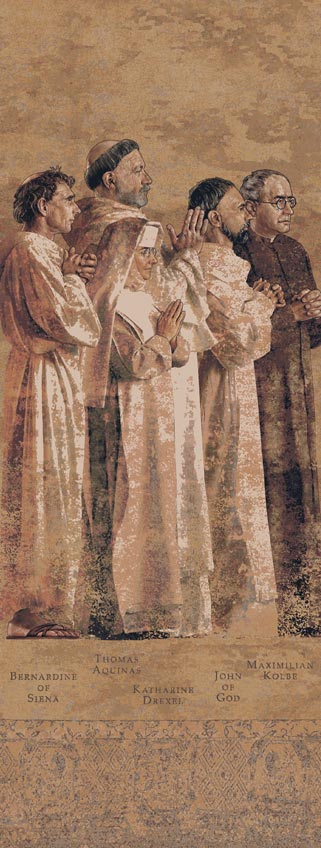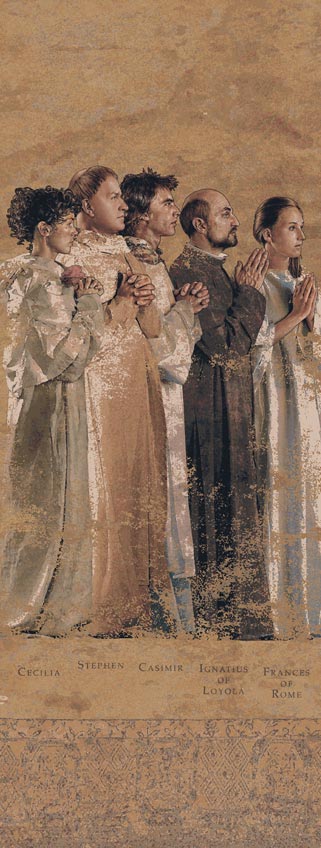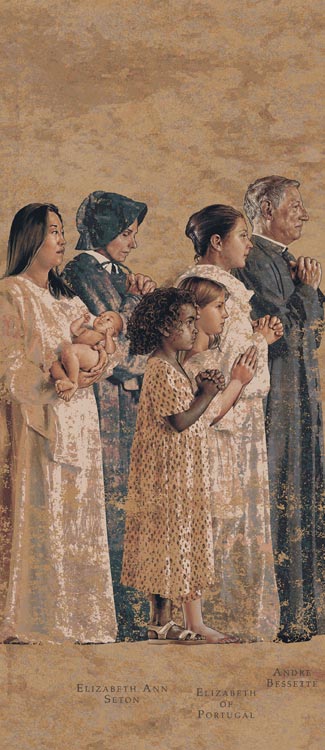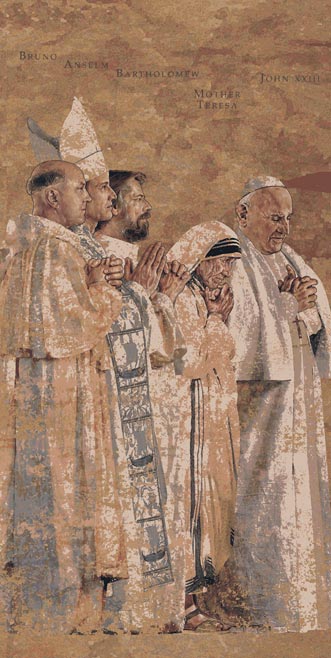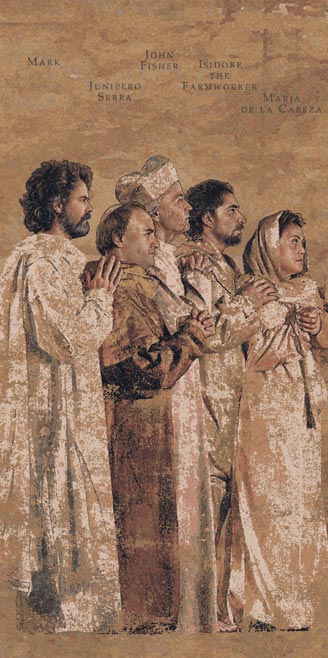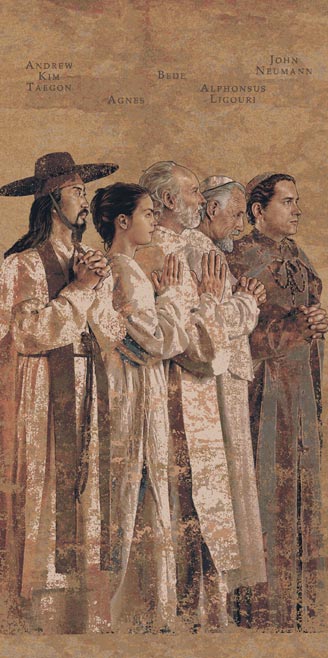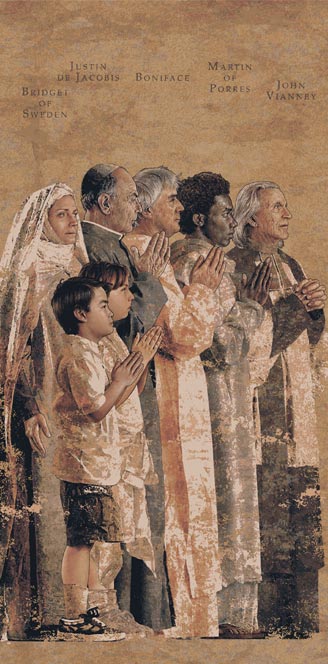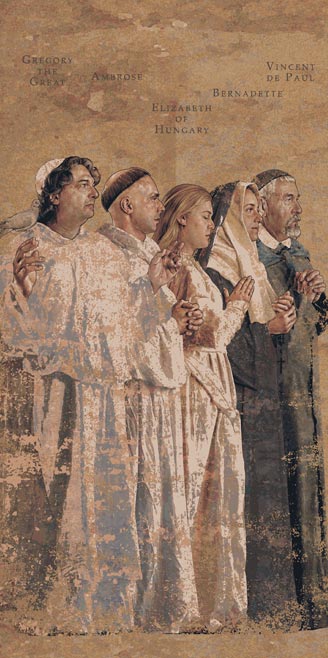January 6: On Pilgrimage
♫ Music:
Day 36 - Sunday, January 6
A Great Multitude from Every Nation
Scripture: Revelation 7:9-12
After this I looked, and behold, a great multitude that no one could number, from every nation, from all tribes and peoples and languages, standing before the throne and before the Lamb, clothed in white robes, with palm branches in their hands, and crying out with a loud voice, “Salvation belongs to our God who sits on the throne, and to the Lamb!” And all the angels were standing around the throne and around the elders and the four living creatures, and they fell on their faces before the throne and worshiped God, saying, “Amen! Blessing and glory and wisdom and thanksgiving and honor and power and might be to our God forever and ever!
Poetry:
The New Jerusalem
by Franz Wright
In the instant before sleep, I saw it
again: Earth
all water, all
ocean! Bathed
in this translucent blue ray, so gorgeous, like
Mary’s--
And I knew again, for the millionth time, knew--
lying all alone there in the dark--you
can shut both your eyes
(you can pluck out your eyes), the light
will still be there
Rilke in one of his letters said Christ
is a pointing,
a finger pointing
at something, and we are like dogs
who keep barking and lunging
at the hand
Grave black grieving face in golden
space
above the sea
which is no more
That is,
which is not yet
ON PILGRIMAGE
According to the traditional church calendar, we’ve come to the end of Christmastide and we’re about to move into Ordinary Time. What can today’s reflection offer us as we say goodbye to a season of joyful celebration and look forward instead to the mundane days ahead, with their routine tasks, commonplace happinesses, and dreary sorrows? The art, poetry, and music today give us both a focus on our destination and some hints about our journey.
Revelation 7 shows us our final goal. Jesus is no longer the baby in the manger, but the glorious Lamb. The petty leaders on this earth, like genocidal Herod, are nothing compared to our God on his throne. This should give us hope. Furthermore, John tells us not just about the throne, but about the crowd around the throne, with people from “every nation, from all tribes and peoples and languages” worshipping the Lamb. According to SIL’s Ethnology there are more than 7000 languages spoken today. Whether the language is extinct, like Hittite; endangered, like Kiowa; spoken by only a few, like the languages in remote valleys in Papua New Guinea; or spoken by many, they will all be used to give glory to God. God’s blessing, honor, and power are so great that all languages are needed to tell of it, to highlight different facets of it, to express different qualities of it. It’s appropriate that our music is in a language, Russian, that may not be familiar to us, but which can still give us a feeling of worship.
Nava’s tapestries also help us see what the multitude around the throne will look like. The 136 saints he depicted are from every era and nation, including Sweden, Japan, Hungary, Peru, and Korea. Some are well known; others are familiar only to history devotees; twelve of them are unnamed. In the close up for today we see Francis Xavier, John Chrysostom, and Mother Cabrini as well as four young people in modern dress who remind us that we too will be part of the throng. (All the John Nava Los Angeles Cathedral tapestries may be viewed by clicking through the images provided on this page.)
John sees a crowd standing before the Lamb. Nava also depicts the saints gazing forward at Jesus, but the linear design hints that they are still on the way and haven’t arrived yet. This is our life now—still on pilgrimage.
Today’s music, from Rachmaninoff’s magnificent choral vespers, is a good soundtrack for this pilgrimage. The first minute and a half could be sung by a procession of pilgrims moving toward their goal, with the altos forming the main line and singing “Glory to God in the highest, and on earth peace.” Other voices echo from ahead and behind in the procession. The deliberate rhythm sets a good walking pace.
Then there’s a shift signaled by a slowing of the music and the bass voices [1:35]. The men are begging mercy for the inhabitants of the earth and the women are lauding Jesus Christ. Suddenly [2:05] the chorus crescendos, singing “to the glory of God the Father. Amen.” It’s as if the procession has caught sight of something “gorgeous,” as Wright describes it in his poem. Glimpses of glory give us new strength for journey.
Then the road turns and we’re back to the dull road of our ordinary days [2:25]. Still, the pace has quickened a bit, as if that glimpse of glory has made the steps of the pilgrims a bit lighter as they sing [2:50] “All the day long I will bless You.”
Moving ahead to a section where Rachmaninoff has high and low voices singing together [4:10], the singers say, “You have been our hiding place from generation to generation.” I imagine these lines coming from the hopeful treble voices of the younger generation and the low voices of the older generation who have walked through many rough places during their lives. I picture the young, old, and middle-aged saints in Nava’s tapestry singing them.
The finale begins [6:20] with three repetitions of “Holy God, Holy Mighty, Holy Immortal, have mercy on us.” After that there’s a brief paean of praise with “Glory to the Father, and to the Son, and to the Holy Spirit, now and ever and forever more. Amen” but the choir returns at the end to a cry for mercy. We are not yet in the new Jerusalem where we can sing glory in eternity; the last words are more suited to our state here on earth: “have mercy on us.”
Prayer:
Lord, give us mercy and strength for our journey. Help us embrace people of different languages and cultures as your saints who are on the journey with us, who have something to teach us about you, and who will one day stand with us before your throne. May our confidence in your ultimate reign give us hope today.
Amen
Kitty Barnhouse Purgason
Chair of the Department of Applied Linguistics and TESOL
Biola University
About the Artwork:
The Communion of Saints, 1999-2002
(Multiple views)
John Nava
Cotton jacquard tapestries woven in Belgium
14-21 ft tall x 7 ft wide
Nave, Cathedral of Our Lady of the Angels, Los Angeles, California
The primary cycle of 25 tapestries for the Cathedral of Our Lady of the Angels in downtown Los Angeles depicts The Communion of Saints and comprise 135 larger than life-size saints from all over the world and throughout the history of the Church against a background of stone from actual scans of excavations of the Via Dolorosa in Jerusalem from the time of the Romans. Twelve untitled figures, including children of all ages, are interspersed with the saints representing the many anonymous holy people in our midst. All the figures face the light of the great Cross-window above the Altar where the Eucharist is celebrated. Artist John Nava combined digital imaging and Old Master painting methods in creating the saints for the tapestries. Significantly, he drafted residents local to the area and friends and family members to serve as models so the figures would look like people we know now, so we might recognize, in the artist’s words, that "a saint could look like me." The Communion of Saints consists of females and males of all ages, races, occupations and vocations the world over. Saints from the Renaissance are intermingled with people from the 1st century and the 20th century. The Baptism, which hangs in the baptistery, depicts Jesus’ baptism by John the Baptist in the Jordan River. The tapestries behind the altar depict a schematic map of the streets of Los Angeles converging with a circular "Cosmati" pattern traditionally associated with the divine and the words of Revelation 21: 3, "See, God's dwelling is among mortals. God will dwell with them. They will be God's people and God will be with them."
About the Artist:
John Nava (b. 1947) is a realist American painter in California. He did his undergraduate work at the University of California Santa Barbara and his graduate work in Florence, Italy. His paintings can be found in collections all over the US, but he has also produced public portraits and murals. Nava has received a number of major public commissions including a 45’ wide mural for the Tokyo Grain Exchange in Tokyo, Japan and a 56’ wide fountain sculpture in Glendale, California, and life-size double portrait for Benaroya Hall in downtown Seattle for the Seattle Symphony. In 1999 Nava was commissioned by the Archdiocese of Los Angeles to do the decoration for the sanctuary of the new Cathedral of Our Lady of the Angels, the largest Catholic cathedral in the United States that opened in 2002, which was initially envisioned as painted murals. Due to acoustical problems the project took a new and challenging direction, resulting in the creation of three major cycles of tapestries. In 2003 Nava’s tapestries for the Cathedral of Our Lady of the Angels won the National Interfaith Forum on Religion, Art and Architecture (IFRAA) Design Honor Award for Visual Art and are widely considered a masterwork of contemporary religious and ecclesial art.
About the Music:
“All-Night Vigil, Op. 37, "Vespers": Great Doxology: Glory be to God on High” from the album Rachmaninoff Vespers
Lyrics:
Slava v vyshnikh Bogu, i na zemli mir, v chelovetsekh blagovoleniye. Khvalim Tya, blagoslovim Tya, klanyayem Ti sya, slavoslovim Tya, blagodarim Tya velikiya radi slavi Tvoyeya. Gospodi, Tsaryu Nebesny, Bozhe Otche, vsederzhitelyu. Gospodi, Syne edinorodny, Iisuse Khriste i Svyatye Dushe. Gospodi Bozhe, Agnche Bozhiy, syne Otech, vzemlyai grekh mira, pomiluy nas: vzemlyai grekhi mira, priimi molitvu nashu. Sedyai odesnuyu Otsa, pomiluy nas. Yako Ty esi edin svyat, Ty esi edin Gospod, Iisus Khristos, v slavu Boga Otsa. Amin. Na vsyak den blagoslovlyu Tya i voskhalyu imya Tvoe vo veki i v vek veka. Spodobi, Gospodi, v den sei bez grekha sokhranitisya nam. Blagosloven esi, Gospodi, Bozhe Otets nashikh, i khvalno i proslavleno imya Tvoye vo veki. Amin.
Budi, Gospodi, milost Tvoya na nas, yakozhe upovakhom na Tya. Blagosloven esi, Gospodi, nauchi mya opravdaniem Tvoyim. Gospodi pribezhishche byl esi nam v rod i rod. Az rekh: Gospodi, pomiluy mya, istseli dushu moyu, yako sogreshikh Tebe. Gospodi, k Tebe pribegokh, nauchi mya tvoriti volyu Tvoyu, yako Ty esi Bog moy, yako u Tebe istochnik zhivota. Vo svete Tvoem uzrim svet. Probavi milost Tvoyu vedushchym Tya. Svyatyi Bozhe, Svyatyi Krepkyi, Svyatyi Bezsmertnyi, pomiluy nas. Slava Otsu, i Synu, i Svyatomu Dukhu, i nyne i prisno, i vo veki vekov. Amin. Svyatyi Bozhe, Svyatyi Krepkyi, Svyatyi Bezsmertnyi, pomiluy nas.
[Translation]:
Glory to God in the highest and on earth peace, goodwill toward men. We praise thee, we bless thee, we worship thee, we glorify thee, we give thanks to thee for thy great glory. O Lord, Heavenly King, God the Father Almighty, O Lord, the only begotten Son, Jesus Christ and the Holy Spirit. O Lord God, Lamb of God, Son of the Father, who takest away the sins of the world, have mercy on us. Thou who takest away the sins of the world, receive our prayer. Thou who sittest at the right hand of the Father, have mercy on us. For thou alone art holy, thou alone art the Lord, Jesus Christ, to the glory of God the Father. Amen. Every day I will bless thee and praise thy name for ever and ever. Vouchsafe, O Lord, to keep us this day without sin. Blessed art thou, O Lord, God of our fathers, and praised and glorified is thy name forever. Amen.
Let thy mercy O Lord, be upon us, as we have set our hope on thee. Blessed art thou, O Lord, teach me thy statutes. Lord, thou hast been our refuge from generation to generation. I said: ‘Lord have mercy on me, heal my soul, for I have sinned against thee. Lord I flee to thee, teach me to do thy will, for thou art my God, for with thee is the fountain of life and in thy light we shall see light. Continue thy mercy on those who know thee. Holy God, Holy Mighty, Holy Immortal, have mercy on us. Glory to the Father, and to the Son, and to the Holy Spirit, both now and ever and unto ages of ages. Amen. Holy Immortal, have mercy on us. Holy God, Holy Mighty, Holy Immortal, have mercy on us.
About the Composer:
Sergey Vasilyevich Rachmaninov (1873-1943), born in Semyonovo, Russia, is today remembered as one of the most formidable pianists of all time and the last truly great composer in the Russian Romantic tradition. At the St. Petersburg Conservatory, his burgeoning talent came into full flower; he received the personal encouragement of Tchaikovsky, and, a year after earning a degree in piano, took the Conservatory's gold medal in composition for his opera Aleko (1892). His All-Night Vigil was composed and premiered in 1915. Russia was in political turmoil at the time. It’s not surprising that Rachmaninov was looking to write something more introspective than usual. The composer, an Orthodox Christian, had a deep and very personal religious faith, which he expresses beautifully through this unaccompanied set of choral prayers. They are separated into two parts: the evening Vespers and the morning Matins, both full of exquisitely rich harmonies. Rachmaninov considered All-Night Vigil his greatest musical achievement.
About the Performers:
Directed by the award-winning conductor Robert Shaw (1916-1999), the Robert Shaw Festival Singers featured in this recording were a group of vocal teachers, conductors, and other choral leaders selected for the 1989 Robert Shaw Festival in Quercy, France. The festival was an esteemed, three-week intensive designed to pass on the riches of Robert Shaw's choral knowledge to a new generation of educators from around the world. Along with studies in pedagogy, the festival resulted in stunning performances and recordings in many historic French cathedrals.
About the Poet:
Franz Wright (1953–2015) was an American poet. He and his father James Wright are the only parent/child pair to have won the Pulitzer Prize in the same category. He earned his BA from Oberlin College in 1977. In his precisely crafted, lyrical poems, Wright addresses the themes of isolation, illness, spirituality, and gratitude. Critic Helen Vendler wrote in the New York Review of Books, “Wright's scale of experience….runs from the homicidal to the ecstatic....His best forms of originality: deftness in patterning, startling metaphors, starkness of speech, compression of both pain and joy, and a stoic self-possession with the agonies and penalties of existence.” Wright received a Whiting Fellowship, a Guggenheim Fellowship, and a grant from the National Endowment for the Arts. He taught at Emerson College and other universities, worked in mental health clinics, and volunteered his time at a center for grieving children.
About the Devotional Writer:
Kitty Barnhouse Purgason
Chair, Department of Applied Linguistics & TESOL
Department of Intercultural Studies
Biola University
Kitty Barnhouse Purgason brings to her classes in TESOL methodology, curriculum, materials and intercultural communication her years of experience living, studying, serving and teaching in India, Russia, Korea, China, Turkey, Turkmenistan, Mauritania, Indonesia, Kuwait, Oman, Tajikistan, Vietnam, and Spain. She has received three Fulbright Fellowships and the Biola Faculty Awards for Excellence in Teaching and Mentoring. She has also been a U.S. State Department English Language Specialist.



